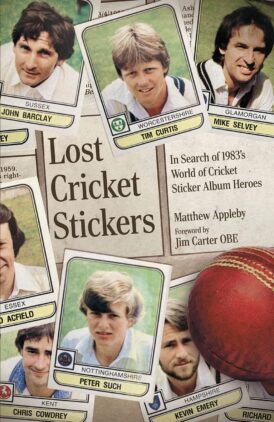Lost Cricket Stickers
Martin Chandler |Published: 2024
Pages: 320
Author: Appleby, Matthew
Publisher: Pitch
Rating: 4 stars

Back in February Matthew Appleby kindly wrote a feature for A Bibliophile’s Blog bearing almost the same title as this one, his second recent book from Pitch. Both are books that look back in time and both have autobiographical elements to them, albeit How To Be A Cricket Fan is rather more of that genre than Lost Cricket Stickers.
Reading Matthew’s article left me a little unclear about what the book itself would be about. Clearly it was going to be a look back at the cricketing summer of 1983, but in fact there is little here in the way of descriptions of the cricket matches themselves. This is rather more a nostalgic nod back towards a world of cricket a long way removed from that we see today.
Forty years on and much has changed. Back in 1983 no one gave India a chance of lifting the third World Cup, but they famously did. It was a huge contrast with 2023 when few saw any real chance of the Indians failing to win last year’s, but in the event they came up short in not dissimilar fashion to that of the all conquering 1983 West Indians. Forty years on of course the men from the Caribbean could not even qualify for the event.
In England, after the World Cup, the New Zealanders won a Test here for the first time, but the focus of Lost Cricket Stickers is the county game. In these pre Durham days the then seventeen counties major prize was the single division County Championship, then sponsored by Schweppes.
Back then there were also three other trophies for the counties to fight over. There was the original knock out cup, played over 60 overs a side, then known as the Nat West Trophy. The Benson and Hedges Cup started in the early season on a regional basis, with the eight leading counties then engaging in three knock out rounds. Finally there was the John Player League, played over forty overs a side on Sunday afternoons.
In 1983 Essex won the Championship, and also reached the Benson and Hedges final, although they lost that one to Middlesex. Somerset won the Nat West and Yorkshire, under 51 year old Ray Illingworth, won the Sunday League. In another year that might have upset your average Lancastrian but nothing could wipe the grins off our faces when, in stark contrast, for the first and so far only time in their history the Yorkshiremen came seventeenth and last in the Championship.
So what has Matthew done with his project? I did originally think it would be a straight chronological voyage through that far off summer, something that has been done before, albeit not to my recollection from such a distance. In the event I was not at all disappointed to discover that the book is not at all what I had been expecting, which was a straightforward rehashing of contemporary reports supplemented by, with the opportunity of forty years reflection, a few soundbites from some of those involved.
But no, this one really is a self-indulgent look back at a happy time in Matthew’s life, and an excuse to go out and interview a selection of those who played a role in the events of that summer, and although in those circumstances the book have greater resonance for those of us of Matthew’s vintage, this is still a delightful helping of nostalgia.
Some of those Matthew spoke to have written books of their own, Jack Russell, Graeme Fowler and John Emburey to name three of them, but that matters little. These are not biographical sketches as such. The conversation harks back to the summer of ’83, but there are plenty of other things that crop up, not least some interesting reflections on the way the game has changed.
In fact of the major stars of English cricket there is only one man present here, that being Sir Geoffrey Boycott, a man as generous with his time in retirement as he was parsimonious with his wicket during his playing career. The man’s elephantine memory helps as well, and the interviews with Boycs and Simon Dennis in the Yorkshire chapter are as interesting as any in the book.
And then there is Kevin Emery of Hampshire. In 1982 Emery came from nowhere to take 83 wickets at 23.72 and form a hugely effective partnership with the legendary Malcolm Marshall. In 1983 he played just five times, took five wickets and that was that. In the intervening years I have often wondered about his back story, and thanks to Matthew I now know it.
Others whose stories make particularly interesting reading are Derbyshire’s Dane, Ole Mortensen, the author’s fellow Cumbrian Graham Monkhouse (Surrey) and, with his Glamorgan cap on, Mike Selvey, a man who has been retired from his day job long enough to no longer have an excuse for not having written an autobiography. Lest I be misunderstood however the selection of just a few names to mention does not in any way detract from the fact that each and every one of the interviews in Lost Cricket Stickers is well worth reading.
The experience of reading a book is, I have worked out over the years, always enhanced when, as here, the author’s enjoyment in writing it comes shining through. That was one of the strengths of Matthew’s last book, and if anything I suspect he had even more fun in putting this one together. To increase the book’s entertainment value Matthew has even slipped in a couple of deliberate mistakes, but I spotted those easily enough and they in no way detract from the pleasure I took from reading the book. I have rated Lost Cricket Stickers as four stars, but for lifelong devotees of the game who are in their early fifties or older that probably should be five.







Leave a comment